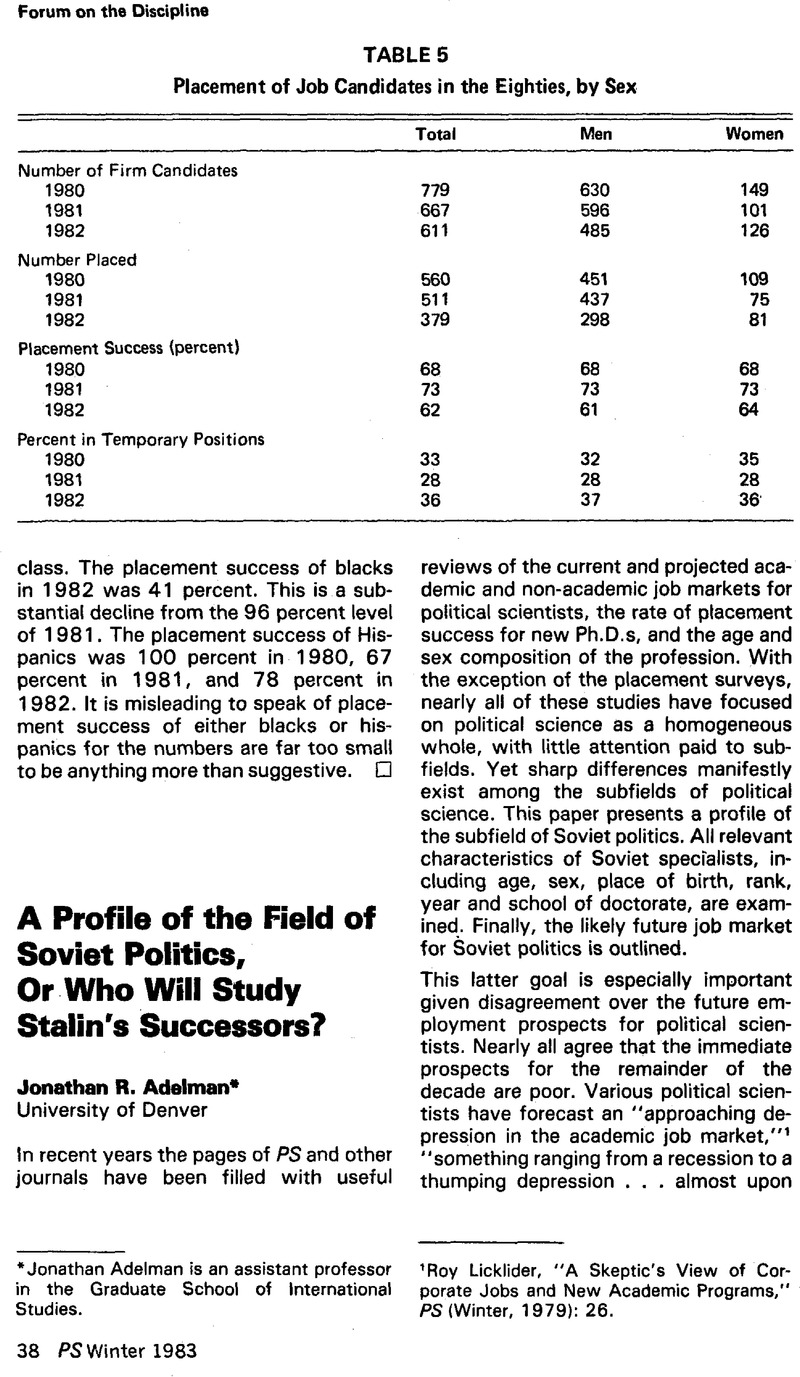No CrossRef data available.
Published online by Cambridge University Press: 25 November 2022

1 Licklider, Roy, “A Skeptic's View of Corporate Jobs and New Academic Programs,” PS (Winter, 1979): 26.CrossRefGoogle Scholar
2 Walker, Jack, “Challenges of Professional Development for Political Science in the Next Decade and Beyond,” PS (Fall, 1978): 484.CrossRefGoogle Scholar
3 Mann, Thomas, “Placement of Political Scientists in 1977,” PS (Winter, 1978): 26.CrossRefGoogle Scholar
4 Kidd, Charles, “New Academic Positions: The Outlook in Europe and North America,” Science 212 (April 17, 1982): 293–297.CrossRefGoogle Scholar
5 Lane, John, “The Slow Graying of the Professoriate,” PS (Winter, 1982): 50.CrossRefGoogle Scholar
6 Columbia (Winter, 1982): 6.
7 International Research and Exchange Board, Foreign Area Research in the National Interest: American and Soviet Perspectives (New York: IREX, 1982).Google Scholar
8 Walen, Jean, Guide to Graduate Study in Political Science—1982 (Washington, D.C.: American Political Science Association, 1982).Google Scholar
9 The major biographical sources were the American Political Science Association, Biographical Directory 1973 (Washington, D.C.: APSA, 1973)Google Scholar, Who's Who in America 1980/1981 (Chicago: Marquis, 1980), and the various regional editions of Who's Who.
10 See American Association for the Advancement of Slavic Studies, Newsletter, Vol. 22 (Spring, 1982): 5.Google Scholar
11 See American Political Science Association, Program for 78th Annual Meeting, September 2–5, 1982 (Washington, D.C.: APSA, 1982).Google Scholar
12 In 1981 54 percent were placed in universities with graduate programs as opposed to 27 percent placed in solely undergraduate programs. See Mann, Sheilah, “Placement of Political Scientists 1980–1981,” PS XV (Winter, 1982): 87.Google Scholar
13 Burton, Doris-Jean, “Ten Years of Affirmative Action and the Changing Status of Women in Political Science,” PS XII (Winter, 1979): 22.Google Scholar
14 Mann, Sheilah, “Placement of Political Scientists 1980–1981,” PS XV (Winter, 1982): 84.CrossRefGoogle Scholar
15 Lane, John, “The Slow Graying of the Professoriate,” PS XV (Winter, 1982): 52.Google Scholar
16 Ibid., p. 51.
17 For the estimation that the average length of time from entry into graduate school until completion of dissertation is nine to ten years, see Sackmann, Peter, “On Dissertations: More Data,” PS VIII (Summer, 1975): 262.CrossRefGoogle Scholar For the data showing a drop from 2,487 entering graduate students in political science in 1969 to 1,042 in 1981, see PS XV (Summer, 1982): 460. For the early evidence of a similar drop in Soviet studies, see the annual survey of dissertations in Slavic Review. While an average of 78 dissertations in Soviet politics, history and foreign policy were listed for the 1970–1980 period, the number dropped to 66 in 1981.
18 Walker, Jack, “Challenges of Professional Development for Political Science in the Next Decade and Beyond,” PS XIL (Fall, 1978): 488.Google Scholar